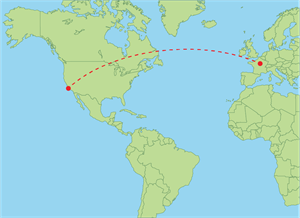
PUMPA - SMART LEARNING
எங்கள் ஆசிரியர்களுடன் 1-ஆன்-1 ஆலோசனை நேரத்தைப் பெறுங்கள். டாப்பர் ஆவதற்கு நாங்கள் பயிற்சி அளிப்போம்
Book Free DemoLength is the distance between one end and the other desired end. In general, it is the measurement of distance. For example, to find the height of a man, the distance between his head and toe should be measured.

Units of length
The SI unit of length is metre (m). This unit is used to measure the length of cloth material, the height of a building, or the lamp post.

For measuring very small lengths like the tip of a pencil or the length of a pen, the units of a millimetre (mm) and centimetre (cm) are used, respectively.

For measuring larger distances, such as the distance between two cities or countries, a larger unit of length called kilometre (km) is used.

Have you ever wondered how sailors calculate the distance at sea?

Sailors use the term called 'nautical miles' to measure the distance at sea.
1 mile = 1.6 kilometres (in land)
1 nautical\ mile = 1.852 kilometres (at sea)
Now we know to calculate the distance at sea, but what about measuring huge distances between celestial bodies in space?
A term called 'light year' is used to measure the distance between celestial bodies.
A light year is defined as the total distance travelled by light in one year.
The speed of light is about 300,000 km\ per\ second. So, the distance covered by the light travelling at a speed of 300,000 km\ per\ second in a year gives one light year.
Calculation of one light year
To calculate one light-year, multiply the total number of days in a year, hours, minutes and seconds in a day. The product of this value should be multiplied by the speed of light (in seconds).
Astronomical units and Parsec are the other units of distance used in space.
Reference:
Free image from, https://freesvg.org/height-measurement
https://cdn.pixabay.com/photo/2012/02/29/15/43/empire-state-building-19109_1280.jpg
https://cdn.pixabay.com/photo/2018/11/07/23/08/sailing-3801448_1280.jpg